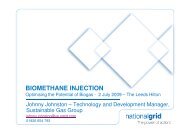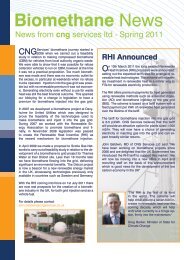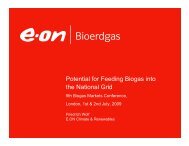Bio-SNG - CNG Services
Bio-SNG - CNG Services
Bio-SNG - CNG Services
You also want an ePaper? Increase the reach of your titles
YUMPU automatically turns print PDFs into web optimized ePapers that Google loves.
BIO-<strong>SNG</strong> FEASIBILITY STUDY – ESTABLISHMENT OF A REGIONAL PROJECTFigure 7.1 (Overleaf) Percentage Net Greenhouse Gas Emissions for <strong>Bio</strong>-<strong>SNG</strong> fired heatingrelative to fossil fuel alternatives for (a) BEAT2 methodology and (b) EC RED methodology and,Percentage Net Greenhouse Gas Emissions for <strong>Bio</strong>-<strong>SNG</strong> transport fuel relative to fossil fuelalternatives for (c) BEAT2 methodology and (d) EC RED methodology (North Energy Associates,June 2010)The data shown illustrates that whilst the actual methodology does have an impact, the following broadconclusions can be drawn:The carbon savings in both the heating and transport sectors are similar<strong>Bio</strong>-<strong>SNG</strong> from virgin biomass typically saves in excess of 90% by either methodologyIn general production from pellets offers slightly lower savings due to energy used in the pelletmanufactureIn general imported feedstock offers slightly lower savingsIn general wastes offer better savings due to the “credits” system (and this is where the differencebetween the two methodologies is most stark)The analysis of RDF (Refuse Derived Fuel) requires a further commentary. The RDF used in this analysisis a high biomass RDF manufactured from mixed waste. The baseline RDF production route used in theanalysis is an autoclave system which uses significant quantities of process heat, which erodes thegreenhouse gas savings. A more typical RDF would be processed using Mechanical <strong>Bio</strong>logicalTreatment which would have a much lower specific energy consumption and would have a greenhousegas saving profile similar to that of cardboard RDF for the biogenic fraction. However in this case, thebiogenic fraction would only be 60% of the biogas, and therefore the greenhouse gas savings would be~60% of that of cardboard RDF – which would therefore offer greenhouse gas savings similar to the RDFcase shown, but for a different reason. This distinction is critical because the incentive structure wouldonly apply to the biogenic fraction, and the greenhouse gas saving per unit of incentive support remainsvery high.It is instructive to note that the detailed analysis here could be approximated by considering the savingsto be at least the full tailpipe emissions associated with individual fossil fuel pathways (ie without needingto consider the full lifecycle analysis) 51In all cases it is assumed that whilst the lifecycle analysis accounts for the emissions associated withdistribution, it is presumed that the existing infrastructure has sufficient capacity (gas and electricity) .51 For example, here the lifecycle emissions of a gas boiler is 245kg/MWh and the emissions for <strong>Bio</strong>-<strong>SNG</strong> usingimported forestry residue is 30kg/MWh is a saving of 215kg/MWh. The tailpipe emission of natural gas is185kg/MWh, so this emissions figure gives an approximate, but conservative savings estimate.62









